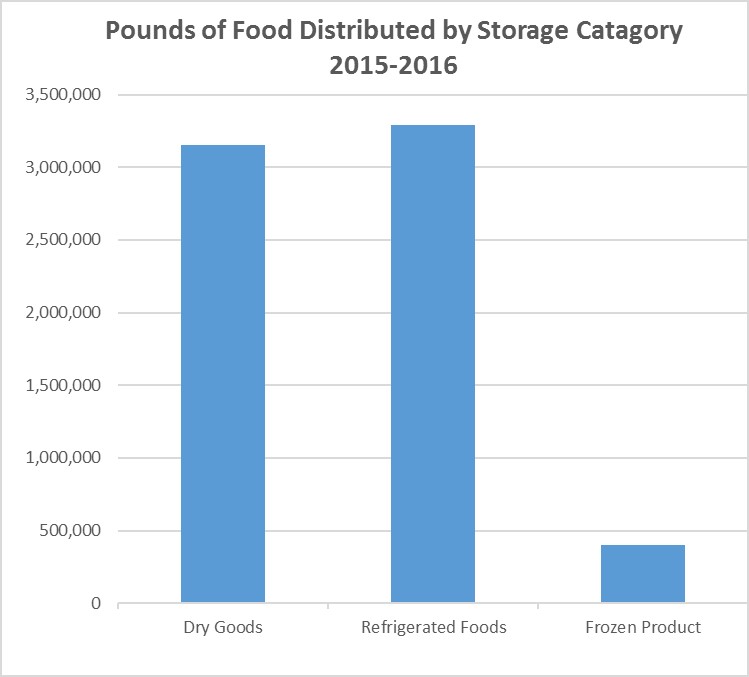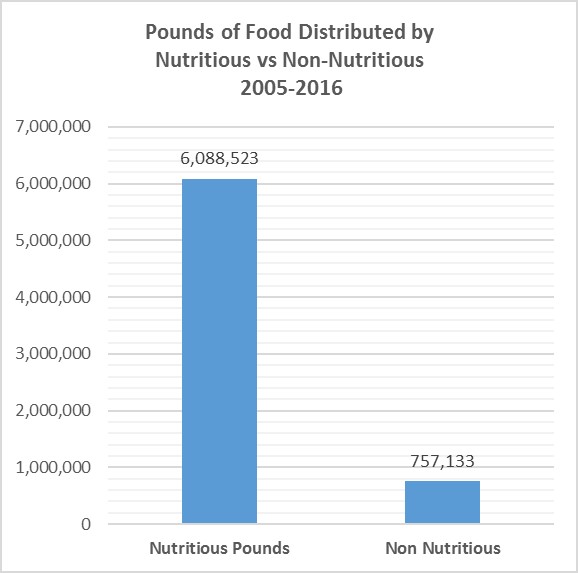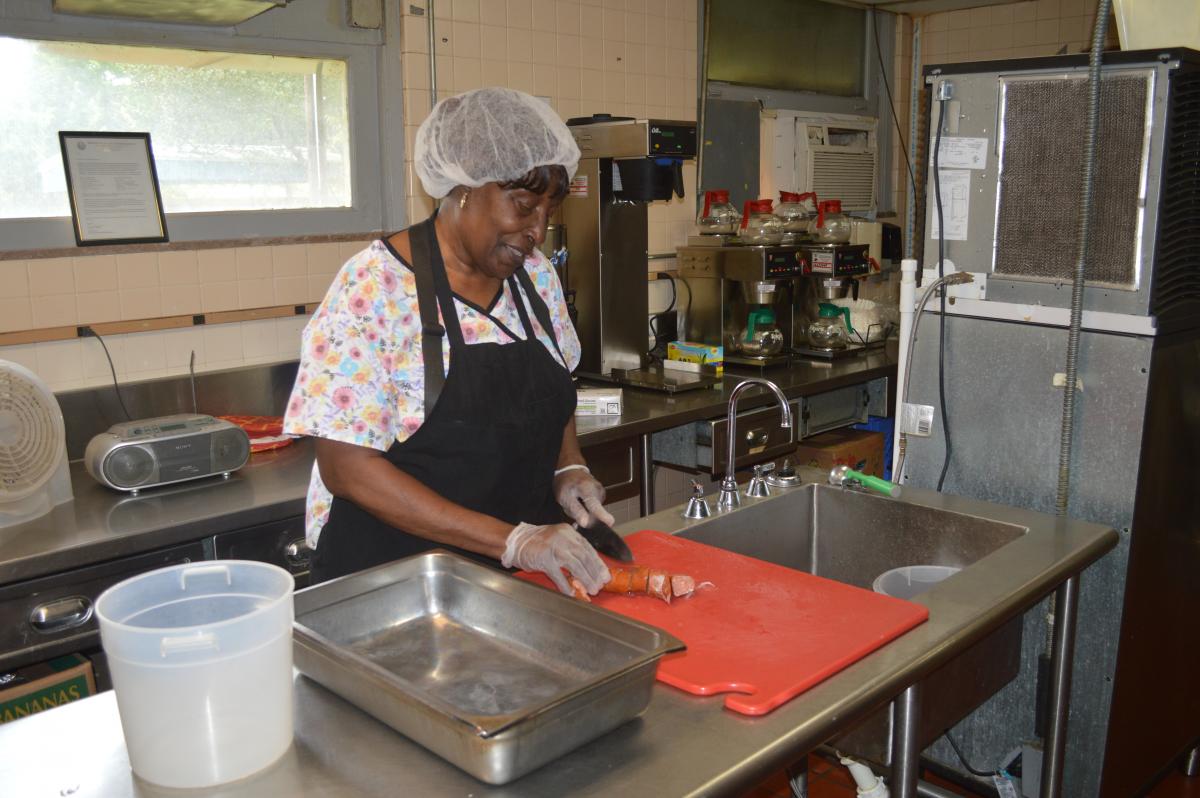
The Brazos Valley Food Bank is a 501c3 nonprofit food bank.
Food banks are centralized and often regional food collection and distribution warehouses that have a goal of collecting and safely storing surplus food, organizing and sorting it with the help of volunteers, then distributing it to areas of high need through partner agencies and special programs to ensure that hungry neighbors are feed. In 2017-2018, the Brazos Valley Food Bank distributed 6,858,438 pounds, or the equivalent of 5,621,670 meals.
To learn more about food insecurity in each county, click on the County link.
All food is distributed through partner agencies and through special programs.
The Brazos Valley Food Bank relies on the generosity of the community at large for the majority of the food it distributes. The United States Department of Agriculture (USDA) also supplies a significant portion of food.
All food is weighed and recorded in a computerized inventory system, inspected and processed by trained volunteers, ordered online by partner agencies (or assembled for special programs), then delivered or picked up for distributed to those who need it.
Donated Food
Donated food accounted for sixty-three percent (63%) of Brazos Valley Food Bank’s total food distribution from 2017 to 2018. Donated product includes:
- Food from food drives (including KBTX’s Food for Families Food Drive)
- Fresh produce procured with the assistance of funds from the Texas Department of Agriculture (TDA) administered by Feeding Texas
- Donations from H-E-B, Kroger, Target, Wal-Mart and Sam’s Club who participate in the Retail Pick Up Program.
- Food from manufactures and wholesalers such as Feather Crest Eggs, Oak Farms Milk, Coca-Cola and Brenham Wholesale
Federal Commodities
Eighteen percent (18%) of the food distributed by the Brazos Valley Food Bank was United States Department of Agriculture (USDA) Commodities. In Texas, USDA Commodities are acquired through the Texas Emergency Food Assistance Program (TEFAP). In the case of the Brazos Valley Food Bank, USDA Commodities are received from the Houston Food Bank. USDA food includes frozen meats, canned and packaged fruits and vegetables, rice, beans pasta, cereals and peanut butter.
Purchased Food
Food that was purchased accounted for ten percent (10%) of the Brazos Valley Food Bank’s food distribution. The Brazos Valley Food Bank purchases food for special programs (like BackPack, where the food needs to be low preparation, individual serving, poptop cans and shelf-stable) and for partner agencies to ensure that certain high priority items are always available (such as rice, tuna, shelf stable milk and ground meat).
Reclamation
Reclaimed food (once called Salvage) accounted for nine percent (9%) of the Brazos Valley Food Bank’s food distribution. Reclamation is cosmetically damaged food donated by grocery store chains and wholesalers to food banks instead and disposing of this product in landfills. This product is quality controlled by trained volunteers (click here to learn more about volunteering) to ensure it is safe for distribution, then sorted and boxed for delivery to partner agencies.
- Food and monetary donations are given to the Brazos Valley Food Bank.
- Receives food donations from various sources, as well as its share of the United States Department of Agriculture Commodities (USDA) from the Houston Food Bank. Also uses some of its donated dollars to purchase other high demand food items. Safely stores all food until it can be inspected, processes, etc.
- Donations are inspected and sorted by volunteers into boxes of various categories that are then created into case items and put into a computerized online inventory. Partner agencies submit online orders for the food they wish to receive to distribute from their feeding program.
- The Brazos Valley Food Bank delivers food orders/food to partner agencies, special programs and drop sites throughout the Brazos Valley.
- Partner agencies, special programs and mobile food pantries distribute the food they received from the Food Bank to those in need.
Generally, when the public thinks of a Food Bank it thinks of shelf-stable, canned goods. And the Brazos Valley Food Bank does distribute these important items. But, fresh produce and frozen items are becoming more prevalent. The Brazos Valley Food Bank has a goal of 50% of the food that it distributes being fresh produce by 2018.
The Brazos Valley Food Bank distributes refrigerated, frozen and shelf-stable foods.
Refrigerated Foods
3,291,761 pounds (48%) is eggs, fresh produce, dairy products and breads/sweets.
Dry Goods
3,150,316 pounds (46%) includes canned fruits and vegetables, canned meats, soups, rice, cereals, pasta, baby food, condiments, paper products, health and beauty products and cleaning supplies.
Frozen Product
403,576 pounds (6%) was includes frozen poultry, ground meat, other assorted meats, frozen vegetable and entrees.
Nutritious Food
6,088,523 pounds (89%) was considered nutritious foods. Nutritious food consists of product like canned fruits and vegetables, canned meats, soups, rice, cereals, pasta, baby food, peanut butter frozen poultry, ground meat, assorted meats, frozen vegetables, entrees, fresh fruits and vegetables. The Brazos Valley Food Bank distributed 785,956 more nutritional pounds than the previous year.
Non-Nutritious Food
757,133 pounds (11%) was non-nutritious. Non-nutritious pounds include non-food items, bread and bakery items, desserts, snack foods, chips and cookies.


The Brazos Valley Food Bank is a Partner Distribution Organization (PDO) of the Houston Food Bank. This means that the Brazos Valley Food Bank contractually provides hunger-relief services to the Brazos Valley for the Houston Food Bank. If the Brazos Valley Food Bank did not exist, the Houston Food Bank would be responsible for serving the Brazos Valley. The Brazos Valley Food Bank receives 6% of the Houston Food Bank’s United States Department of Agricultures (USDA) Commodities).
The Brazos Valley Food Bank is also a member of Feeding Texas, Texas’ Food Bank Network and a distribution organization of Feeding America the nation’s Food Bank Network. The Brazos Valley Food Bank upholds strict food and personnel safety, pest maintenance, being audited annually by the Houston Food Bank. The Brazos Valley Food Bank is also inspected by Texas Department of State Health Services.
Eighty-One point One percent (81.1%) of food distributed by the Brazos Valley Food Bank passes through partner agencies.
Three point seven percent (3.7%) of the food distributed is through the Brazos Valley Food Bank’s children's programs - Children’s BackPacks, School-Based Food Pantries.
Three percent (3.0%) of the food distributed is through the Brazos Valley Food Bank's Mobile Food Pantries.
Point Nine percent (0.9%) of the food distributed is through the Brazos Valley Food Bank's Senior Outreach Program - Senior Bags.
Greater than point one percent (>0.1%) of the food distributed is through the Brazos Valley Food Bank's Screen & Intervene Program.
Three point four percent (3.4%) of the food distributed is through "Other" Brazos Valley Food Bank special events*.
Another 7.9% is distributed through accredited drop sites*.
* Special events include Thanksgiving in the Brazos Valley, Holiday Distribution, and Emergency Family Boxes.
* Examples of drop sites including Public Housing, and BVCOG Agencies, Meals on Wheels and WIC.
Food Distribution Partner Agencies
The Brazos Valley Food Bank partners with 36 food pantries, emergency shelters, soup kitchens, and programs for youth, senior citizens, and the disabled to provide more than 6 million pounds of food to the community each year.
The Brazos Valley Food Bank gets it food from public and private donations, grocery store reclamation, the United States Department of Agriculture (USDA), wholesalers, and the Houston Food Bank. Food is distributed to approved Brazos Valley Food Bank partner agencies for a Shared Maintenance Fee of approximately $0.19/lb. The Shared Maintenance Fee helps the Brazos Valley Food Bank acquire, sort, store, refrigerate, and distribute this food.
Agencies that distribute non-perishable and fresh foods to all food insecure individuals in the communities they serve are called public pantries. These groceries are distributed in pre-packaged boxes/bags or by letting families and individuals “shop” (using a system called Client Choice) in the pantry and choose their own food. 
The Brazos Valley Food Bank currently partners with these public pantries in the Brazos Valley:
Bedias Food Pantry
Brazos Church Pantry
Bread Partners of Washington County
Caldwell Christian Care
Call for Help
Christian Community Services
Elizabeth Lutheran Church
Faith Mission
First Baptist Church of College Station
In God’s Hands
Iola Church of Christ
Lee Chapel
Lincoln House of Hope
Mission Reclaimed
Progressive Missionary Baptist Church
Robertson County Cares
Salvation Army
SonShine Outreach Center
The Bridge Ministries
For location, hours, and contact information, or if you are in need of food assistance, see our Get Food page.
Non-profit and religious organizations that already provide services to individuals in need and want to distribute supplemental groceries to their clients can do so. These pantries, which are not open to the public, distribute non- perishable and fresh foods to the families and individuals who participate in their agency’s programs and services.

The Brazos Valley Food Bank currently partners with 5 client pantries:
LULAC Oak Hill
Project Unity Special Health Services
Project Unity Texas Families Together and Safe
St. Vincent de Paul
Twin City Mission
Programs that provide prepared meals and/or health snacks to individuals are onsite feeding partners. These include public sites (i.e. soup kitchens, snack sites, etc.) and client-based programs (i.e. treatment centers, shelters, after-school programs, etc.).
The Brazos Valley Food Bank currently partners with 7 onsite feeding partners:
BVCASA
Adult & Teen Challenge of Texas
Madison County House of Hope
MHMR Authority Mary Lake Day Center
SOS Ministries
Boys & Girls Club of the Brazos Valley
Boys & Girls Club of Austin County
Programs that provide prepared meals and/or health snacks to individuals are onsite feeding partners. These include public sites (i.e. soup kitchens, snack sites, etc.) and client-based programs (i.e. treatment centers, shelters, after-school programs, etc.).
The Brazos Valley Food Bank currently partners with 7 onsite feeding partners:
BVCASA
Adult & Teen Challenge of Texas
Madison County House of Hope
MHMR Authority Mary Lake Day Center
SOS Ministries
Boys & Girls Club of the Brazos Valley
Boys & Girls Club of Austin County
